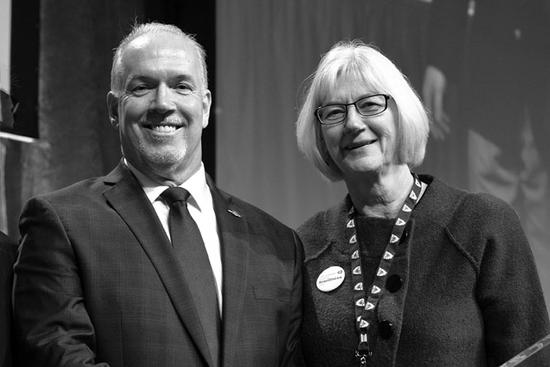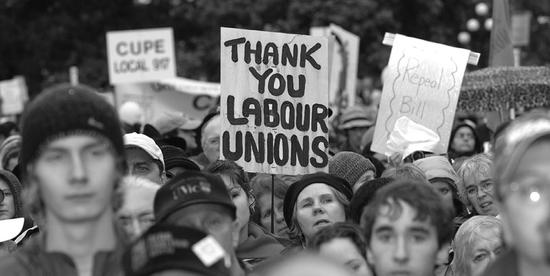24. The Struggle Continues
After more than 150 years of struggle marked by death, hardship, sacrifice, many bitter defeats and eventually a long period of solid gains and achievements, the British Columbia labour movement has survived as a fighting force into the twenty-first century. But the challenges ahead are rife. As their percentage of the workforce has dipped, unions have declined in clout—particularly those in the private sector. According to Statistics Canada, BC experienced a six-point drop in the percentage of workers belonging to a union between 1996 and 2013, the biggest decline in the country. Mostly this is the result of a major fall in size of private-sector unions: from as high as 30 percent of all non-government workers several decades ago to about 18 percent today.
Changes in the workforce have made it challenging for unions to maintain their former footing. Employment in BC has shifted from once powerful manufacturing and resource-based industries that were mostly unionized to the service sector, where it is difficult for unions to make sustained inroads. Historic gains such as the eight-hour day, decent pensions and job security are under attack. More than 75 percent of all employed British Columbians are now service providers. Employee units are becoming smaller and harder to organize, compared with the large industrial plants of the past. More and more jobs are temporary, part-time, contract or self-employed. Heightened global competition, free trade and the fluidity of investment capital have also taken a toll. This increasingly competitive environment puts downward pressure on wages, making it harder for unions to pursue one of the chief rationales for their existence, better pay.
The climate is especially difficult for younger workers. Polls show many are interested in joining unions, but openings are not easy to find, as union workforces shrink. Younger workers often wind up in the expanding world of information technology—which has yet to be unionized in a meaningful way—or in poorly paid service jobs. As private-sector unions struggle, the underpinning of the labour movement has moved to the still heavily unionized public sector. More than three-quarters of all those employed by government and Crown corporations have union cards, making up more than 60 percent of the membership of the BC Federation of Labour. In spite of the strains, there is no sign of trade unions becoming extinct. They remain a key force protecting and advancing the cause of all workers in a no-holds-barred economy.
But labour leaders understand they need to do more to face the future and engage younger workers. In the fall of 2016, the Canadian Labour Congress organized the first-ever Young Worker Summit in Ottawa, which made news when delegates gave Prime Minister Justin Trudeau a rough ride. The United Food and Commercial Workers has a number of initiatives and internships aimed at youth, while the BC Federation of Labour, along with other large labour organizations, has an activist Young Workers’ Committee open to anyone under thirty-one.

Long-established unions are merging to better combine their forces for the battles ahead. In 2013, the Canadian Auto Workers (CAW) and the Communications, Energy and Paperworkers Union joined together to form Unifor, the country’s largest private-sector union, with more than three hundred thousand members. Earlier, even the fabled IWA, its membership hovering around twelve thousand, opted to cast its lot with the United Steelworkers. And before its merger, the CAW had already absorbed most of the independent Canadian unions.
The fifty-seventh convention of the BC Federation of Labour provided a convenient snapshot of the state of BC’s unions in the fall of 2016. The changes, as well as labour’s timeless travails, were on full display. There was history at the top. Welcoming the 950 delegates representing half a million workers was Irene Lanzinger, the first woman to head BC’s voice of organized labour. Rather than congratulating the Federation, Lanzinger asked, rhetorically, “Why did it take so long?” Systemic leadership barriers to women remain, she said, pointing out that the presidents of twelve of BC’s fourteen largest unions were men.
Lanzinger had replaced the shaggy-haired Jim Sinclair, the Fed’s loud and passionate president of fifteen years. Controversial at times, Sinclair left his mark on the organization, championing causes outside the realm of contracts, working behind the scenes to try to resolve difficult disputes and articulating labour’s beefs with fire and conviction. Lanzinger, a veteran of the BCTF, was the first member of a public-sector union to head the Federation. Illustrating just how far diversity has come, Lanzinger was also undoubtedly the first Fed president to cite labour as a movement “that vigorously engages in the battle against racism, sexism, ableism, homophobia, transphobia and xenophobia.”

At the same time, problems cited by the Fed president would have been familiar to anyone attending a convention fifty years earlier: continued attacks on unions by those she branded as “the rich and the powerful”; the ongoing fight to ensure safe workplaces; low wages and precarious employment; the failure of governments to reduce poverty, provide sufficient child care and establish an adequate minimum wage; and the need to elect political leaders committed to social issues. Lanzinger’s ringing cry that “our response must be to build a movement that includes and fights for every member of the working class and the poor” could have been uttered at any time in labour’s distant past.
And of course, there was division. The labour movement has never been short of strong opinions, and they don’t always merge. As Lanzinger acknowledged, a split had deepened over jobs and the environment, epitomized by the Site C dam and Kinder Morgan pipeline. Construction unions are attracted by the thousands of jobs. Others in the labour movement oppose the projects for their potential damage to the environment.
What of the years ahead? In spite of the best efforts of business, media commentators and right-wing politicians to dismiss them as anachronisms in the modern, rapidly evolving gigabyte economy, unions aren’t going away. Indeed, they are needed more than ever. Continuing to push the envelope of workers’ rights, they are moving, however haltingly, into the difficult terrain of high-tech electronics and fields dominated by computers. In January of 2017, the International Alliance of Theatrical Stage Employees stepped up an organizing drive among Vancouver’s many studio animators with what the union called “a major town hall meeting” at a location kept secret from studio managers. Unifor Local 2000, the former Newspaper Guild, has also been in the field trying to organize animators, visual-effects workers and video-game developers.
As 2017 progressed, despite ongoing economic uncertainty, strike votes were soaring: 99.5 percent by Kitimat smelter workers; 96 percent by four thousand housekeeping and dietary workers at BC hospitals; and 99.4 percent by more than a thousand workers at the River Rock Casino seeking a first contract after being organized in 2016 by the BCGEU. The summer of 2017 saw a return to power by the BC NDP, in a minority government with Green Party support, after sixteen years of Liberal government. Backed by strong union support, the NDP promised a substantial increase in the minimum wage to $15 an hour and less onerous rules for union organizing.
It will not be easy. It never is for unions. But the dream of a better society for working men and women keeps the movement going, long after so many other social movements have passed into the dustbin of history. The ringing words of labour’s rousing anthem “Solidarity Forever,” written by Wobbly Ralph Chaplin in 1915, have never gone out of style: “When the union’s inspiration through the workers’ blood shall run/ There can be no power greater anywhere beneath the sun/ Yet what force on earth is weaker than the feeble strength of one/ But the union makes us strong.”
The next chapter awaits.


